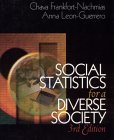

![]()
![]()

The authors emphasize a variety of specific and distinctive features of social statistics. The close links between the practice of statistics, important social issues and real-world examples illustrate how methods of inquiry interplay with real data from a particular society. A focus on diversity helps to understand how race, class, gender, and other characteristics shape our societies and influence social behaviour.
The content of the book is organized in fifteen chapters and six appendixes. It begins by explaining the role of theory, the importance of research questions, the formulation of hypotheses and the processes of data collection. A description of basic concepts of statistics (such as dependent and independent variables, discrete and continuous variables, nominal, ordinal, interval-ratio and other levels of measurement, descriptive and inferential statistics) is also given here.
Further chapters familiarize readers with various methods of descriptive and inferential statistics. First of all, readers learn how to organize information using descriptive techniques, such as frequency distributions, percentage distributions, rations and rates. Statistical measures of variation are described for the exploration of differences and diversity within society. Methods of bivariate analysis are specially suited to examining how variables such a race, class, ethnicity, gender, religion and other operate in shaping social behaviours. Two additional chapters are included on a CD packaged with every copy of the text: they discuss inference in regression, analysis of variance and provide a brief overview of multiple regression techniques. A description of the methods of inferential statistics is given in the second half of the book. The main inferential statistics methods discussed are the Z, t, and chi-square. The authors also discuss how to determine the error involved in using survey samples.
Several chapters illustrate how graphic presentation helps to explore the differences and similarities among the social groups. Bar chart, time series chart, pie chart, the statistical map and many other graphical devices are presented. Each chapter ends with a list of main points and key terms discussed in that chapter. Definitions of the key terms also appear in the body of the chapter. Key terms are also clearly defined and explained in the index/glossary. Moreover, most chapters contain guides to reading and interpreting research reports written by social scientists. This material is included because statistical analyses presented in the scientific publications are usually more complex than class and textbook presentations. The book includes a demonstration of related SPSS procedures and exercises at the end of each chapter.
A strength of this book is teaching basic statistics through the incorporation of numerous substantive examples and real-world data applications. The majority exercises and examples are based on General Social Survey and U.S. Census data. For example, frequency distributions are demonstrated through the changes of marriage and divorce rates in U.S. from 1970 to 1995, standard error is demonstrated by using the data of migration and the earnings of Hispanic men declared in the 1980 census, and so on.
I found the content of this book consistent, well structured and written in a very simple and clear manner. The strength of the book is the way it combines basics of mathematics and elements of advanced statistics in one publication. Without doubt, this book will be very useful both for students and researchers who lack math backgrounds but hope to develop more rigorous methods for analysing social data.
Vida Cesnuityte
The Law University of Lithuania